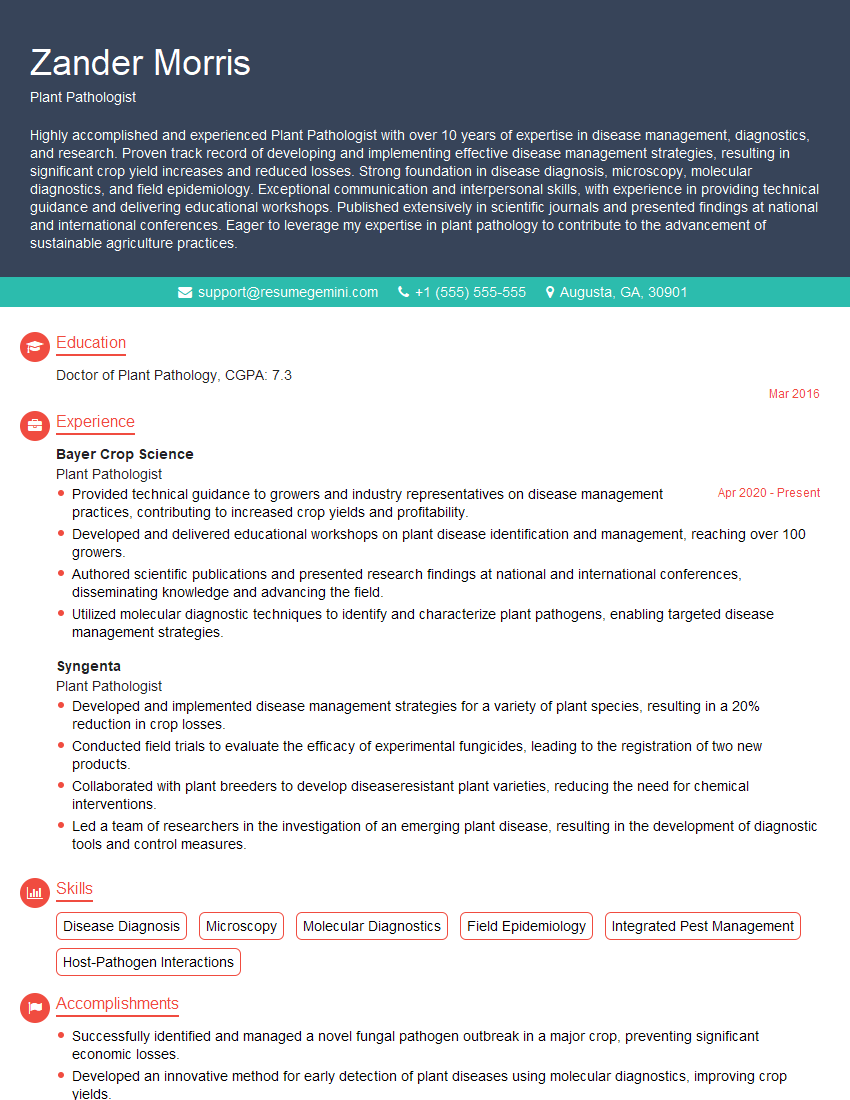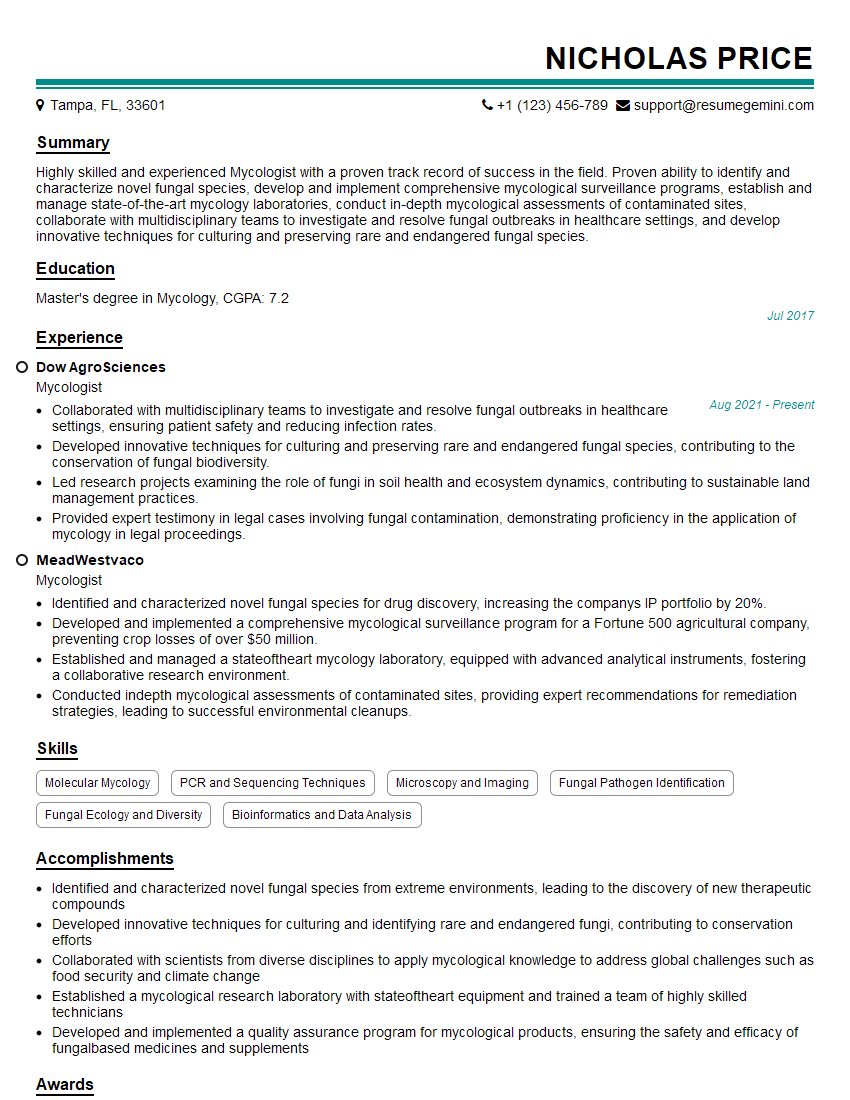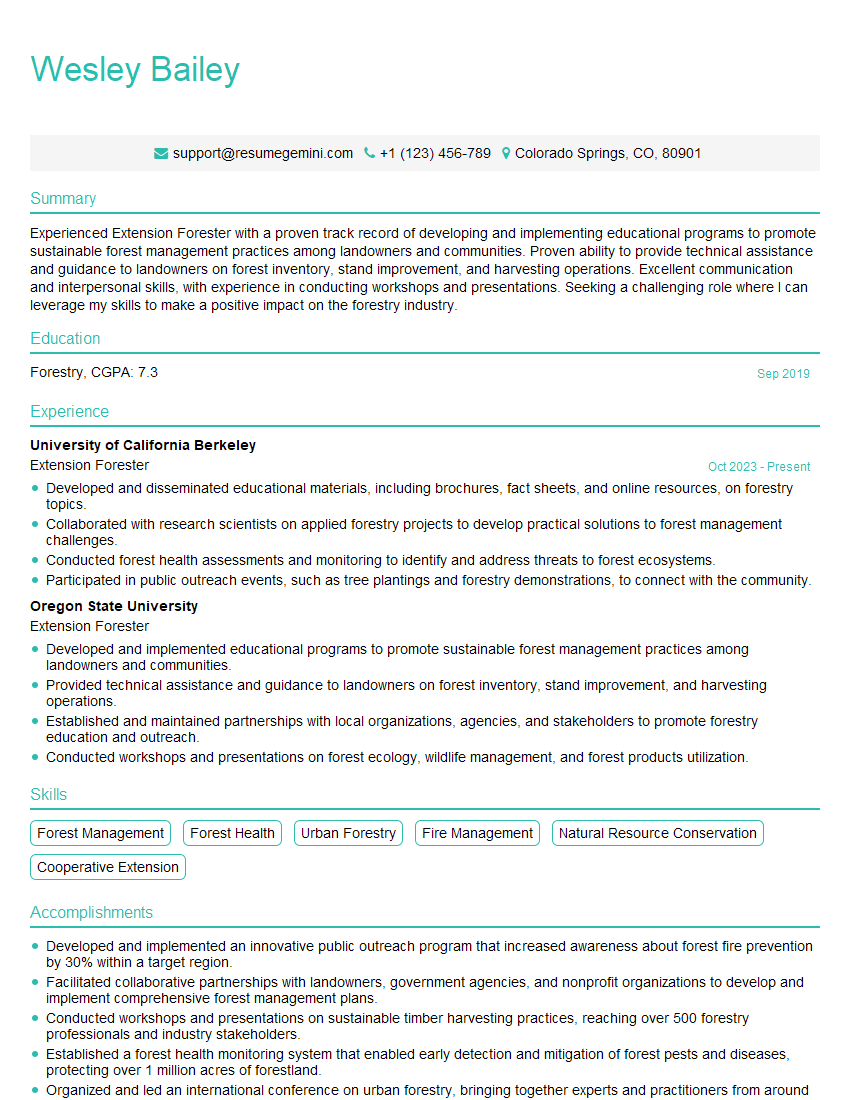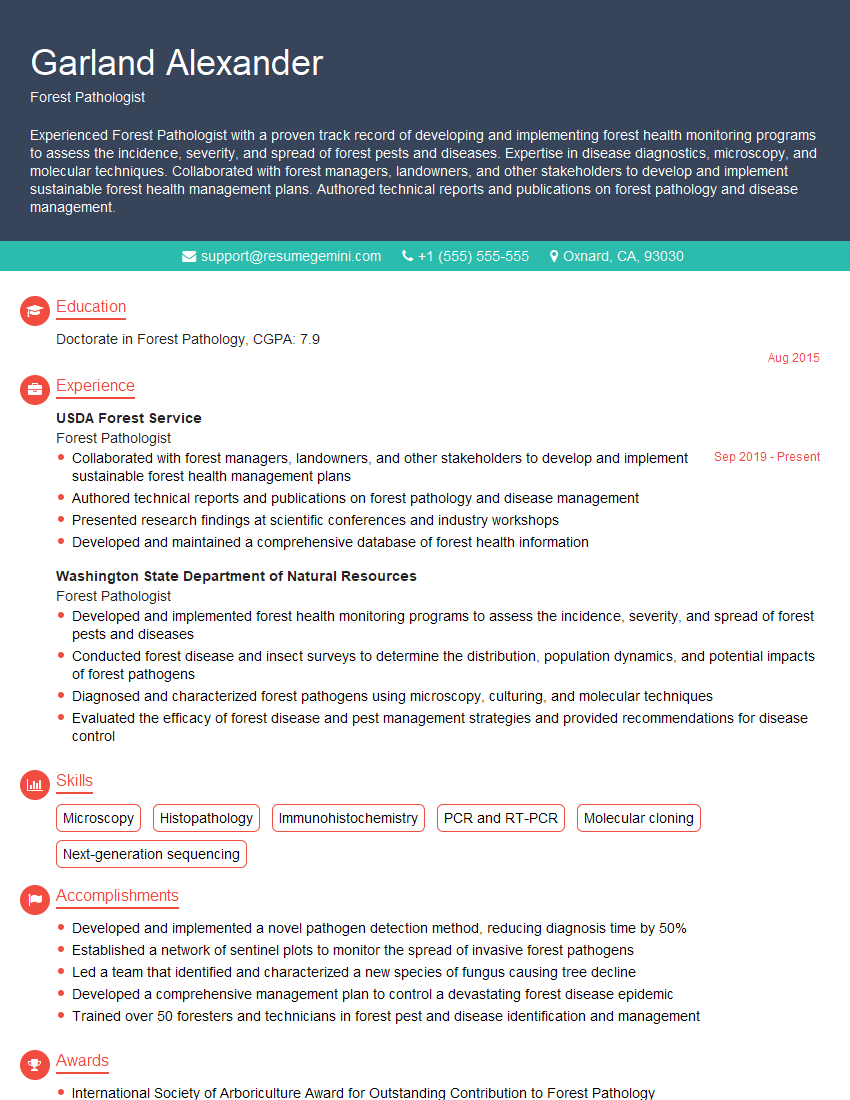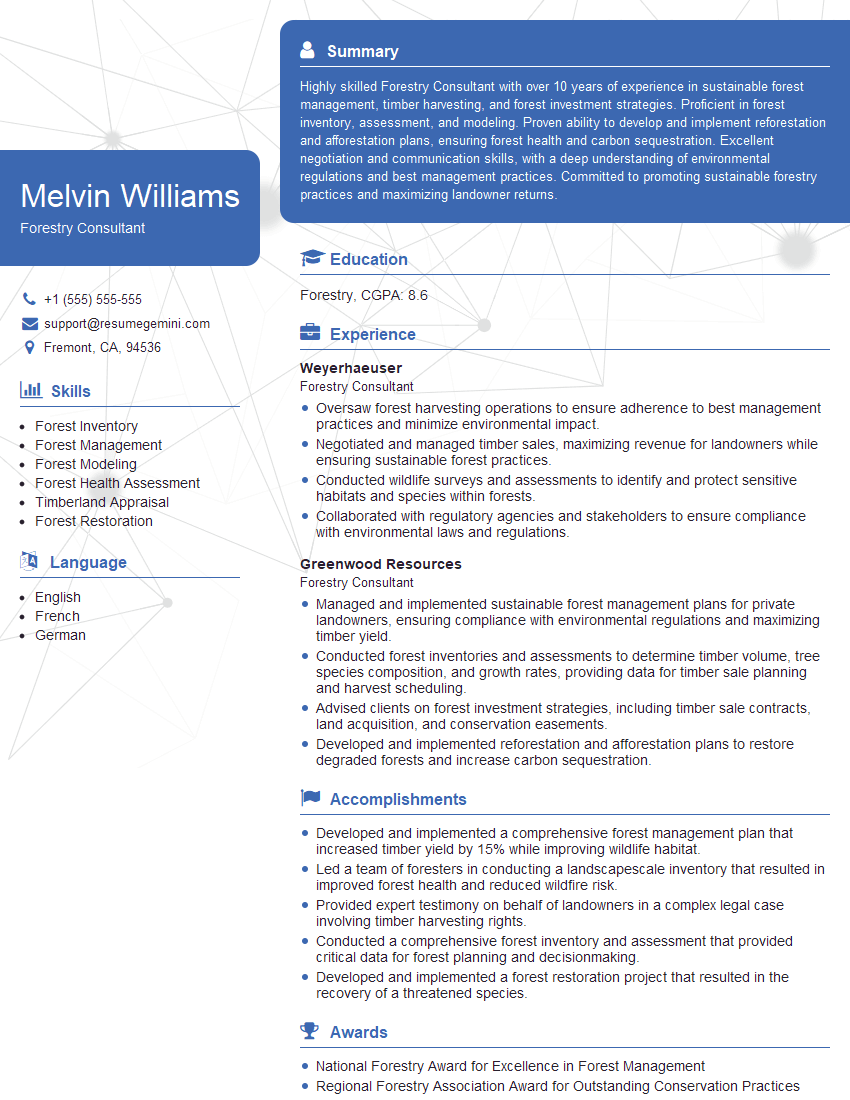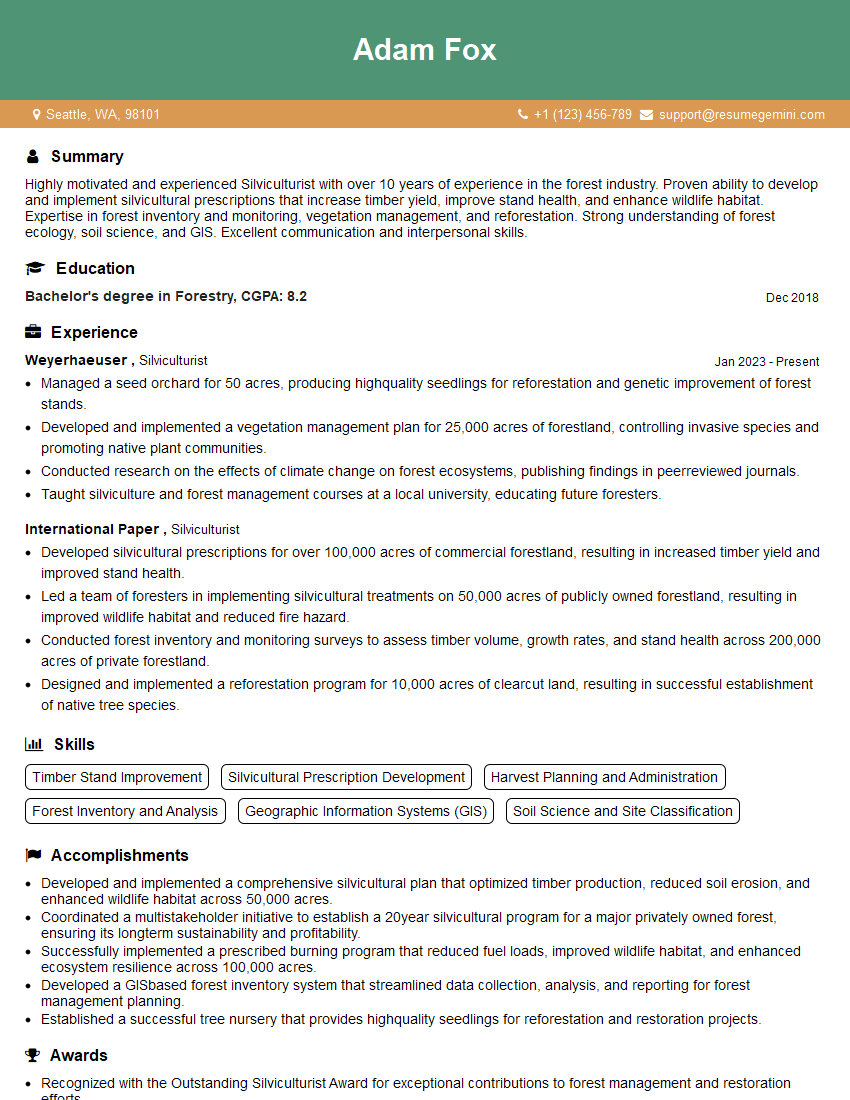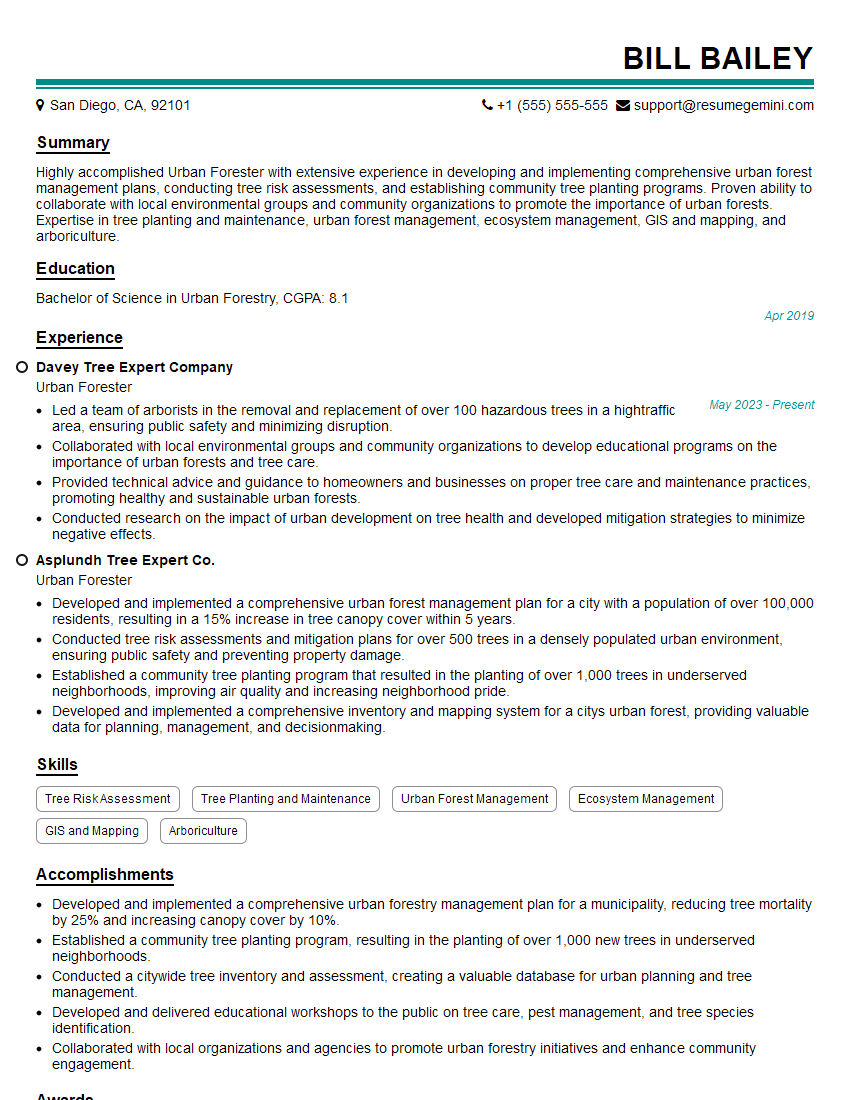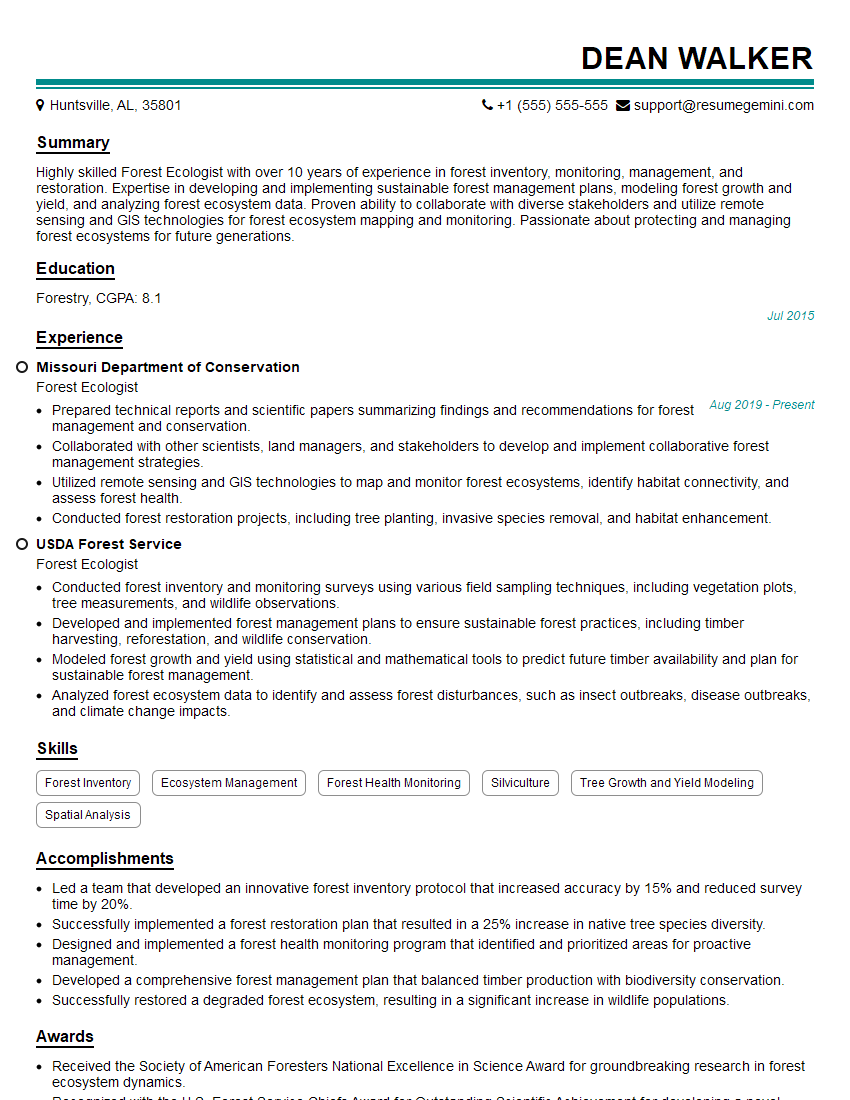The thought of an interview can be nerve-wracking, but the right preparation can make all the difference. Explore this comprehensive guide to Forest Health and Pathology interview questions and gain the confidence you need to showcase your abilities and secure the role.
Questions Asked in Forest Health and Pathology Interview
Q 1. Describe the life cycle of a common forest pathogen in your region.
Let’s explore the life cycle of Phytophthora ramorum, the causal agent of Sudden Oak Death, a prevalent pathogen in my region (assuming a region with a history of SOD). This pathogen’s life cycle is complex, involving both sexual and asexual reproduction.
Asexual Reproduction: P. ramorum primarily spreads asexually through the production of chlamydospores, thick-walled resting spores highly resistant to environmental stress. These spores can survive in infected plant debris for extended periods, serving as inoculum for future infections. Rainsplash and water movement are key dispersal mechanisms, allowing spores to spread to healthy plants. The pathogen also produces sporangia that release zoospores, motile spores capable of swimming short distances in water films on leaves and branches. This enables rapid spread within a canopy or between nearby plants.
Sexual Reproduction: While less common, P. ramorum can also reproduce sexually, resulting in greater genetic diversity and increased adaptability. This process requires the presence of both mating types (A1 and A2) within the same host plant or close proximity. Sexual reproduction generates oospores, even more resistant survival structures than chlamydospores, enhancing the pathogen’s long-term persistence in the environment.
Infection and Disease Development: After infection, P. ramorum colonizes the plant’s tissues, causing lesions and eventually leading to leaf blight, stem cankers, and ultimately, death of the host, especially in oak and tanoak trees. The pathogen thrives in moist conditions, and warm temperatures can accelerate disease progression.
Understanding this complex life cycle is critical for effective disease management strategies, emphasizing the importance of sanitation, removing infected plant debris, and employing resistant plant species where available.
Q 2. Explain the difference between biotic and abiotic factors affecting forest health.
Forest health is a delicate balance influenced by both biotic and abiotic factors. Biotic factors are living organisms within the forest ecosystem, while abiotic factors are non-living components.
Biotic Factors: These include all the living organisms interacting within the forest, such as insects, pathogens (fungi, bacteria, viruses), nematodes, plants (competing species or parasitic plants), and wildlife. For example, an outbreak of mountain pine beetles can decimate large swaths of pine forest, while a fungal root disease can weaken trees making them susceptible to windthrow.
Abiotic Factors: These encompass the physical and chemical conditions of the environment. Examples include climate (temperature, precipitation, sunlight), soil properties (nutrient availability, drainage, pH), topography (elevation, aspect, slope), air pollution, and natural disasters (fire, flood, windstorms). A prolonged drought, for example, can stress trees, making them more vulnerable to insect attack or disease. Similarly, soil compaction can limit root growth, hindering nutrient and water uptake.
Distinguishing between these factors is essential for accurate diagnosis and effective management. A decline in tree health may be caused by a single factor or a combination of both biotic and abiotic stresses. For instance, a drought (abiotic) might weaken trees, making them more susceptible to a bark beetle infestation (biotic).
Q 3. What are the key symptoms of Dutch Elm Disease?
Dutch Elm Disease (DED), caused by the fungus Ophiostoma ulmi (and its more aggressive variant O. novo-ulmi), is characterized by a range of symptoms, often appearing in a specific progression.
Early Symptoms: Initially, you might notice wilting and yellowing of leaves, typically affecting only one or a few branches. The leaves may droop or curl, and the affected branches might appear stunted.
Intermediate Symptoms: As the disease progresses, more extensive wilting occurs. Leaves become brown and brittle, and they may remain attached to the branches for some time even after death. Discoloration of the sapwood (the lighter-colored wood just beneath the bark) is often a key indicator, visible as streaks of brown or dark brown running up and down the branches.
Advanced Symptoms: In severe cases, entire branches or even the entire tree crown will wilt and die. The tree may exhibit dieback, starting at the top and progressively moving down. In later stages, dead branches may be scattered throughout the crown, creating a sparse and unhealthy appearance.
It’s crucial to note that these symptoms can sometimes mimic other tree ailments, requiring careful examination and potentially laboratory testing for a definitive diagnosis.
Q 4. How do you diagnose a fungal infection in a tree?
Diagnosing a fungal infection in a tree often requires a multi-pronged approach combining visual inspection with laboratory techniques.
Visual Inspection: This involves carefully examining the tree for characteristic symptoms such as leaf spots, cankers, wilting, dieback, fruiting bodies (mushrooms, conks), or root rot. The location and pattern of symptoms can provide valuable clues to the specific pathogen. For instance, root rot symptoms often manifest as general decline, thinning crown, and drooping branches.
Sampling: Depending on the suspected disease, samples of infected tissues (leaves, twigs, bark, roots) are collected using sterile techniques to avoid contamination. Samples should be representative of the infected areas and adequately sized for laboratory analysis.
Laboratory Analysis: This is usually the definitive step. The collected samples undergo microscopic examination to identify the fungal structures (hyphae, spores, fruiting bodies). Additionally, isolation and culturing of the fungus on specialized media might be necessary for species identification and further pathogenicity testing.
Molecular Diagnostics: Advanced techniques like Polymerase Chain Reaction (PCR) can be used to detect the DNA of specific fungal pathogens, providing rapid and sensitive diagnosis, even in cases where the fungus is difficult to isolate or identify microscopically.
A combination of these methods ensures a precise diagnosis, guiding appropriate treatment or management strategies.
Q 5. What are the common methods for controlling insect pests in forests?
Controlling insect pests in forests necessitates a balanced and integrated approach, as reliance on a single method can be ineffective and environmentally damaging.
Biological Control: This involves introducing natural enemies of the pest, such as predators, parasitoids, or pathogens. For example, releasing parasitic wasps to control defoliating caterpillars. Careful selection and monitoring of biological control agents are essential to ensure they target only the pest insect and do not harm beneficial species.
Chemical Control: While often necessary, chemical insecticides should be used judiciously and sparingly due to potential negative impacts on non-target organisms and the environment. Targeted applications, using specific insecticides that affect only the pest species, are preferred. Integrated Pest Management (IPM) principles guide the responsible use of chemical controls.
Silvicultural Methods: These are forest management practices that manipulate the forest environment to reduce pest susceptibility. This can include thinning stands to reduce tree density, promoting species diversity, or managing understory vegetation. Healthy and vigorous trees are naturally more resistant to pests.
Monitoring and Early Detection: Regular monitoring of forests for pest activity using traps, surveys, and remote sensing technologies allows for early detection of infestations, enabling rapid intervention before widespread damage occurs.
The most effective strategies often involve integrating several of these methods to achieve sustainable and environmentally sound pest management.
Q 6. Describe various sampling techniques used for assessing forest health.
Assessing forest health requires a systematic sampling approach to obtain representative data from a large and diverse area. Several techniques are commonly employed:
Fixed-radius plots: A circular plot of a predetermined size (e.g., 0.1 ha) is established at various points across the forest. Within each plot, all trees meeting specified criteria (e.g., diameter at breast height, species) are measured and assessed for health indicators (e.g., crown condition, signs of disease or insect attack).
Line transects: A straight line is established, and trees along the line within a specified distance are assessed. This method is particularly useful for assessing linear features such as riparian areas or roadsides.
Cluster sampling: Plots are grouped together in clusters, which are randomly located throughout the forest. This is more efficient than simple random sampling when dealing with large areas.
Remote sensing: Aerial photography, satellite imagery, and LiDAR (Light Detection and Ranging) can provide large-scale assessments of forest health by capturing data on canopy cover, tree density, and spectral characteristics indicative of stress. Data analysis often involves sophisticated image processing techniques.
Ground-based assessments: Combining ground-based sampling with remote sensing provides a more comprehensive understanding of forest health, bridging the gap between detailed individual-tree assessments and larger-scale landscape patterns.
The choice of sampling technique depends on factors such as the objective of the assessment, the size and accessibility of the forest, and the resources available. Proper statistical analysis is crucial to ensure the collected data accurately represents the forest health status.
Q 7. Explain the role of integrated pest management (IPM) in forest health.
Integrated Pest Management (IPM) is a holistic and sustainable approach to managing pests in forests, emphasizing prevention and minimizing reliance on harmful chemical controls.
Monitoring and Scouting: Regularly monitor forests for pests to detect potential problems early. Identify pests using appropriate techniques and assess the level of damage.
Economic Thresholds: Establish economic thresholds that define the pest population level at which control measures become economically justified. Intervention only occurs when the cost of inaction exceeds the cost of control.
Prevention and Resistance: Use various strategies to prevent pest establishment or reduce their impact, including the use of resistant tree species or genotypes, or silvicultural practices that create less favorable habitats for pests.
Integrated Control Tactics: Employ a combination of biological, chemical, and cultural controls, selecting the most appropriate options based on the specific circumstances and considering the ecological context. Prioritize low-impact methods before resorting to more intensive interventions.
Evaluation and Documentation: Regularly evaluate the effectiveness of IPM strategies to continuously adapt and optimize pest management efforts. Maintain detailed records of pest occurrences, damage levels, and control measures.
IPM ensures long-term forest health by preventing pest outbreaks, protecting biodiversity, and minimizing environmental damage. It’s a proactive and adaptive approach, constantly evolving to best address pest challenges while maintaining the integrity of the forest ecosystem.
Q 8. What are the impacts of climate change on forest pathology?
Climate change significantly impacts forest pathology by altering the conditions that favor disease outbreaks. Warmer temperatures, altered precipitation patterns, and increased frequency of extreme weather events create ideal environments for many pathogens and pests. For example, warmer winters can reduce the mortality of insect pests that would normally die off during colder periods, leading to population explosions and increased damage to trees. Changes in rainfall can increase humidity, favoring fungal diseases, while drought stress weakens trees, making them more susceptible to attack. Increased storm damage creates entry points for pathogens into previously healthy trees. In essence, climate change acts as a stress multiplier, exacerbating existing problems and creating new challenges for forest health.
Consider the impact on mountain pine beetles: milder winters allow larger populations to survive and expand their range, leading to devastating outbreaks across vast areas of forest. Similarly, the range expansion of fungal diseases like sudden oak death is directly linked to warmer temperatures and altered precipitation.
Q 9. How do you assess the risk of a forest fire outbreak?
Assessing forest fire risk involves integrating several factors into a comprehensive risk assessment. This is often done using a combination of on-the-ground observation and sophisticated modeling. We look at factors like:
- Fuel Load: The amount of combustible material (dead leaves, branches, undergrowth) present. Higher fuel loads increase flammability.
- Fuel Moisture Content: The dryness of the fuel. Drier fuels ignite and burn more readily.
- Weather Conditions: High temperatures, low humidity, and strong winds are crucial factors. These create conditions that allow fires to start easily and spread rapidly.
- Topography: Steep slopes accelerate fire spread, and canyons can channel flames.
- Historical Fire Data: Past fire occurrences and behavior provide valuable insight into future risk.
Many jurisdictions utilize sophisticated fire danger rating systems that combine these factors into a numerical index. This index helps land managers prioritize areas for preventative measures, like prescribed burns, and guides firefighting strategies during an outbreak. For example, the Canadian Forest Fire Danger Rating System uses weather data and fuel type to calculate a daily fire danger rating, ranging from low to extreme.
Q 10. Discuss the importance of forest biodiversity in maintaining forest health.
Forest biodiversity is paramount to maintaining forest health. Think of a forest as an intricate ecosystem where different species play interconnected roles. A diverse forest is more resilient to disturbances such as disease outbreaks, insect infestations, and climate change. This resilience arises from several mechanisms:
- Reduced Susceptibility to Disease: A high diversity of tree species means that if one species is susceptible to a particular disease, others are less likely to be affected, preventing widespread damage.
- Increased Pest Resistance: A variety of tree species reduces the likelihood that a single pest will find a large, homogenous population to feed upon.
- Enhanced Nutrient Cycling: Diverse plant communities contribute to a richer soil ecosystem, improving nutrient availability and overall forest productivity.
- Improved Ecosystem Services: Diverse forests provide a wider range of ecosystem services, including carbon sequestration, water purification, and wildlife habitat.
Imagine a monoculture forest – a forest composed of a single tree species. A disease or pest affecting that single species could devastate the entire forest. Contrast this with a diverse forest where the impact of a disease or pest is buffered by the presence of other species. The diversity acts as a form of natural insurance.
Q 11. What are the common methods of forest regeneration?
Forest regeneration, the process of re-establishing a forest after disturbance, utilizes various methods, each suited to specific site conditions and objectives:
- Natural Regeneration: Allowing trees to regenerate naturally from seed or root suckers. This is the most cost-effective method but can be slow and unpredictable.
- Artificial Regeneration: Active human intervention to establish trees. This includes:
- Planting: Planting seedlings or saplings directly into the ground.
- Sowing: Broadcasting seeds over the area.
- Assisted Natural Regeneration: A combination of natural and artificial methods, where human intervention is used to enhance natural regeneration processes (e.g., removing competing vegetation, protecting seedlings).
The choice of method often depends on factors like site accessibility, species characteristics, and available resources. For example, in areas with poor seed dispersal, planting may be necessary. In areas with adequate seed sources and minimal competition, natural regeneration might be preferred.
Q 12. Explain the role of mycorrhizae in forest ecosystems.
Mycorrhizae are symbiotic relationships between fungi and plant roots. The fungi form a network of hyphae (thread-like structures) that extend into the soil, significantly enhancing the plant’s ability to absorb water and nutrients. In return, the plant provides the fungi with carbohydrates produced through photosynthesis. This mutually beneficial relationship is crucial to forest ecosystems:
- Improved Nutrient Uptake: Mycorrhizae increase the surface area for nutrient absorption, making nutrients more available to trees, especially phosphorus.
- Enhanced Water Uptake: Mycorrhizal fungi extend the reach of the root system, improving access to water, especially in dry conditions.
- Increased Disease Resistance: Some mycorrhizal fungi produce antibiotics or other compounds that protect plant roots from pathogens.
- Improved Soil Structure: Mycorrhizal hyphae bind soil particles together, improving soil structure and reducing erosion.
Mycorrhizae are essential for the health and productivity of many forest ecosystems. Their loss or disruption can significantly impact forest growth and resilience.
Q 13. How do you identify and manage invasive plant species?
Identifying and managing invasive plant species requires a multi-pronged approach:
- Identification: Accurate identification is the first step. This involves understanding the plant’s morphology, its preferred habitat, and its growth patterns. Field guides, online databases, and expert consultation are crucial tools. For example, correctly identifying Japanese knotweed is vital to implement effective control measures.
- Monitoring: Regular monitoring helps track the spread of invasive species and allows for early detection of new infestations. This might involve visual surveys, aerial photography, or remote sensing technologies.
- Control Methods: The choice of control method depends on the species, the extent of the infestation, and environmental considerations. Methods include:
- Mechanical Control: Physical removal of plants (e.g., hand-pulling, mowing).
- Chemical Control: Using herbicides to kill plants. Carefully selecting appropriate herbicides and adhering to safety regulations is crucial.
- Biological Control: Introducing natural enemies (e.g., insects, diseases) to control invasive plants. This requires rigorous testing to ensure that the biological control agent doesn’t harm native species.
A successful invasive species management program typically involves a combination of these methods. For example, a large infestation might be tackled using an integrated approach, beginning with herbicide treatment followed by ongoing monitoring and mechanical removal to prevent re-establishment.
Q 14. What are the economic impacts of forest diseases?
Forest diseases have significant economic impacts, affecting various sectors:
- Timber Production: Disease outbreaks can lead to reduced timber volume and quality, resulting in lower yields and increased costs for harvesting and processing. For example, an outbreak of Dutch elm disease can decimate entire stands of elm trees.
- Forest Products Industry: The reduced availability of healthy timber impacts industries that rely on wood products, such as furniture making, paper production, and construction.
- Tourism and Recreation: Diseases can affect the aesthetic value of forests, reducing tourism and recreation opportunities. For example, a severe pine wilt disease outbreak can make forests visually unappealing and unsafe for recreational activities.
- Ecosystem Services: The degradation of forest ecosystems due to disease reduces their ability to provide vital services like carbon sequestration, water purification, and soil stabilization, resulting in indirect economic costs.
- Control and Management Costs: Significant financial resources are required for disease detection, monitoring, and management, including research, surveillance, and treatment.
The cumulative economic impact of forest diseases can be substantial, affecting both local communities and national economies. Accurate assessments of these impacts are critical for prioritizing resources and implementing effective management strategies.
Q 15. Describe various disease resistance mechanisms in trees.
Trees, like all living organisms, possess a range of defense mechanisms against diseases. These can be broadly categorized into pre-formed (constitutive) and induced defenses.
- Pre-formed defenses: These are physical and chemical barriers always present in the tree. Examples include thick bark acting as a physical barrier, the presence of waxes and resins that repel pathogens, and the production of antimicrobial compounds like phenols and tannins.
- Induced defenses: These defenses are activated only after a tree encounters a pathogen. They are faster and more specific than constitutive defenses. This includes the hypersensitive response, where infected cells undergo programmed cell death to prevent pathogen spread. Another example is the production of pathogenesis-related (PR) proteins, which have various antimicrobial activities. The formation of lignin, a complex polymer that strengthens cell walls and impedes pathogen movement, is another induced defense.
Think of it like a castle with a moat (constitutive defense) and soldiers (induced defense) ready to fight off attackers. The effectiveness of these mechanisms depends on various factors including tree species, genetics, environmental conditions, and the virulence of the pathogen.
Career Expert Tips:
- Ace those interviews! Prepare effectively by reviewing the Top 50 Most Common Interview Questions on ResumeGemini.
- Navigate your job search with confidence! Explore a wide range of Career Tips on ResumeGemini. Learn about common challenges and recommendations to overcome them.
- Craft the perfect resume! Master the Art of Resume Writing with ResumeGemini’s guide. Showcase your unique qualifications and achievements effectively.
- Don’t miss out on holiday savings! Build your dream resume with ResumeGemini’s ATS optimized templates.
Q 16. How do you use remote sensing technologies to monitor forest health?
Remote sensing is a powerful tool for monitoring forest health over large areas. We utilize various technologies, primarily satellite and airborne imagery, to detect subtle changes indicative of disease or stress.
- Multispectral imagery: Captures data across different wavelengths of light, allowing us to identify variations in vegetation indices like Normalized Difference Vegetation Index (NDVI). Reduced NDVI often suggests stress, indicating potential disease or infestation.
- Hyperspectral imagery: Provides much finer spectral resolution, enabling the detection of specific biochemical changes in leaves, indicative of disease symptoms that might be invisible to the naked eye or multispectral sensors. We can see subtle shifts in pigment concentrations or water content.
- LiDAR (Light Detection and Ranging): Uses laser pulses to create 3D models of the forest canopy, providing information about tree height, density, and structural changes. This helps to detect areas of thinning or mortality associated with disease outbreaks.
The data collected is analyzed using Geographic Information Systems (GIS) and specialized software to create maps visualizing forest health and identify areas requiring further investigation. For instance, a significant drop in NDVI in a specific area might trigger a ground-based survey to confirm the presence of a disease and determine its extent.
Q 17. What is the importance of forest health monitoring programs?
Forest health monitoring programs are crucial for the sustainable management of our forests. They provide early warning systems for disease outbreaks, enabling timely intervention and preventing widespread damage. These programs also help us:
- Assess the overall health of forest ecosystems: Identifying trends in tree vigor, susceptibility to pests and diseases, and the impact of climate change.
- Guide forest management practices: Informing decisions on harvesting, replanting, and other interventions to maintain forest health and productivity.
- Track the effectiveness of management interventions: Assessing the success of treatment strategies and preventative measures.
- Protect biodiversity: Identifying and monitoring areas with high conservation value and mitigating threats to rare or endangered species.
- Support public health and safety: Monitoring for the presence of diseases that could impact human health, such as those carried by insects.
Imagine a doctor conducting regular check-ups – forest monitoring programs play a similar role, ensuring the long-term health and vitality of our forests.
Q 18. Explain the concept of forest resilience.
Forest resilience refers to the capacity of a forest ecosystem to withstand, adapt to, and recover from disturbances, whether natural (e.g., storms, fires, insect outbreaks) or human-induced (e.g., deforestation, climate change). A resilient forest is not necessarily free from disturbances, but it can absorb shocks and maintain its essential functions and structures over time.
Key factors contributing to forest resilience include:
- Biodiversity: A diverse forest is less vulnerable to widespread damage because different species have different tolerances to stress and diseases.
- Structural complexity: A forest with a variety of tree sizes, ages, and species is better able to withstand disturbances than a monoculture.
- Connectivity: The ability of forests to connect with each other through corridors allows for species migration and facilitates recovery after disturbances.
- Adaptive capacity: The ability of species and ecosystems to adjust to changing conditions.
For instance, a forest with a mix of tree species might experience some mortality during a drought, but the overall ecosystem will likely remain functional because other species are better adapted to dry conditions.
Q 19. What are some of the ethical considerations in forest management?
Ethical considerations in forest management are paramount, particularly in balancing human needs with ecological sustainability. Key issues include:
- Protecting biodiversity: Ensuring the conservation of endangered species and maintaining ecosystem integrity.
- Sustainable harvesting practices: Balancing the demand for timber with the need to maintain forest health and regeneration capacity.
- Indigenous rights and traditional forest management practices: Respecting the rights of indigenous communities and their traditional knowledge in forest management.
- Climate change mitigation: Recognizing the role of forests in carbon sequestration and adapting management practices to climate change impacts.
- Transparency and accountability: Ensuring that forest management decisions are open and accountable to the public.
Consider the example of clear-cutting versus selective logging. While clear-cutting might be economically efficient in the short term, it can have significant negative impacts on biodiversity and forest resilience. Ethical forestry considers the long-term ecological and social consequences of management choices.
Q 20. Describe different forest ecosystem types and their susceptibility to diseases.
Forest ecosystems are incredibly diverse, and their susceptibility to disease varies greatly. Factors like climate, soil conditions, tree species composition, and stand density all play a significant role.
- Boreal forests: Characterized by coniferous trees like spruce and pine, they are susceptible to outbreaks of insects like spruce budworm and diseases like root diseases. Cold temperatures can also influence disease progression.
- Temperate deciduous forests: With a mix of hardwood trees like oak, maple, and beech, these forests can be affected by a wide range of diseases, including fungal leaf diseases, cankers, and root rots. The impact of diseases can be influenced by the humidity and temperature.
- Tropical rainforests: High biodiversity and warm, humid conditions create a favorable environment for a large number of pathogens. Disease outbreaks can have devastating consequences, but the impact is often complex and difficult to predict due to the complex interactions between species.
For example, a monoculture of a particular tree species is far more vulnerable to a disease outbreak than a diverse forest. The lack of genetic diversity makes it easier for the pathogen to spread rapidly.
Q 21. How do you communicate complex forest health issues to the public?
Communicating complex forest health issues to the public requires careful consideration of the audience and the message. Key strategies include:
- Using simple language and avoiding jargon: Explaining complex concepts in clear, concise terms that everyone can understand.
- Employing visuals: Using maps, photos, and videos to illustrate key points and make the information more engaging.
- Telling stories: Sharing relatable examples and anecdotes to connect with the audience emotionally.
- Using multiple communication channels: Reaching the public through websites, social media, news articles, and public presentations.
- Engaging with the community: Organizing workshops, tours, and other events to foster dialogue and build trust.
For example, instead of saying “increased incidence of Phytophthora ramorum”, we might explain that a devastating disease is killing trees and affecting local ecosystems. We can then follow it up with images showcasing the impact and ways individuals can help.
Q 22. What is your experience with using GIS software for forest health assessments?
GIS software is an indispensable tool in my work. I’ve extensively used ArcGIS and QGIS for various aspects of forest health assessments, from mapping disease outbreaks and pest infestations to analyzing spatial patterns of forest degradation. For example, during an assessment of oak decline in a national park, I used ArcGIS to overlay data layers showing tree species composition, soil type, elevation, and proximity to water sources. This spatial analysis helped identify key environmental factors contributing to the decline and guided targeted interventions.
My experience encompasses data input, processing, analysis (e.g., spatial autocorrelation, overlay analysis), and visualization. I’m proficient in geoprocessing tools to create custom maps, charts, and reports to communicate findings clearly and effectively to stakeholders. Specifically, I’ve utilized tools like spatial interpolation to predict disease spread based on observed infections, greatly aiding in proactive management strategies.
Q 23. Describe a time you had to troubleshoot a difficult forest health problem.
One challenging case involved a sudden and widespread die-off of Douglas fir trees in a remote area. Initial symptoms were vague – needle discoloration and stunted growth – making diagnosis difficult. Standard pest and disease surveys yielded inconclusive results. To troubleshoot, I employed a multi-faceted approach:
- Detailed Site Investigation: I conducted thorough on-site surveys, collecting soil and tissue samples from affected and healthy trees.
- Laboratory Analysis: The samples were sent to a specialized lab for pathogen identification and soil nutrient analysis.
- Environmental Data Collection: I gathered data on rainfall, temperature, and other climatic factors using weather stations and historical records.
- Collaboration: I consulted with other forest pathologists and entomologists to share findings and perspectives.
Ultimately, we determined the die-off was caused by a combination of drought stress, exacerbated by a previously unknown root rot fungus identified through advanced molecular techniques. This case highlighted the importance of integrating various diagnostic methods and collaborative efforts in solving complex forest health problems.
Q 24. Explain your understanding of forest certification schemes (e.g., FSC).
Forest certification schemes, such as the Forest Stewardship Council (FSC), are voluntary standards designed to promote sustainable forest management practices. FSC certification ensures that wood and forest products originate from responsibly managed forests meeting stringent environmental, social, and economic criteria. The certification process involves rigorous audits to verify compliance with the standards.
My understanding includes the key principles of FSC, such as maintaining biodiversity, protecting endangered species, conserving water resources, and ensuring the rights of indigenous peoples and local communities. I’m familiar with the chain-of-custody system which tracks certified products from forest to market, ensuring traceability and transparency.
In practical terms, FSC certification can influence forest health positively by incentivizing sustainable management practices, reducing the risk of forest degradation, and promoting responsible harvesting methods that minimize impacts on forest ecosystems. It’s a significant mechanism for improving forest health at a global scale.
Q 25. What are the common legal and regulatory frameworks related to forest health?
Legal and regulatory frameworks related to forest health vary considerably depending on jurisdiction, but common themes include:
- Pest and Disease Control: Laws often mandate reporting and control of invasive species and forest diseases to prevent widespread outbreaks. This might involve quarantine regulations, treatment programs, and restrictions on the movement of plant materials.
- Forest Protection: Legislation protects forest resources through regulations on logging, land use, and development in forest areas. This often incorporates elements to prevent deforestation and habitat loss.
- Environmental Impact Assessments: Projects with potential impact on forests typically require environmental impact assessments (EIAs) to evaluate risks and mitigation measures.
- Endangered Species Protection: Laws safeguard endangered species and their habitats, influencing forest management practices to ensure their survival.
These frameworks are crucial for safeguarding forest health, preventing ecological damage, and promoting sustainable forest management. Compliance is essential for forest managers and landowners. Ignorance of relevant laws and regulations can result in significant penalties.
Q 26. How do you stay up-to-date with advancements in forest pathology?
Staying current in forest pathology requires a multi-pronged approach. I regularly subscribe to and read scientific journals such as Forest Pathology and Phytopathology. I actively participate in professional organizations like the International Union of Forest Research Organizations (IUFRO) and attend conferences and workshops to learn about the latest research and best practices.
Online resources, such as the USDA Forest Service website and various university research databases, are invaluable sources of information. I also maintain a network of colleagues and experts in the field, engaging in discussions and collaborations to share knowledge and learn from their experiences. Continuous learning is crucial to effectively address the ever-evolving challenges in forest health.
Q 27. Describe your experience with data analysis in the context of forest health.
Data analysis is central to my work. I regularly use statistical software (R, SAS) and programming languages (Python) to analyze datasets related to forest health. This includes analyzing tree growth data, disease incidence rates, and environmental variables to identify trends, patterns, and correlations.
For instance, I recently used R to perform regression analysis on a dataset of tree mortality rates and climate variables to assess the impact of drought on forest health. The analysis revealed a strong positive correlation between drought severity and tree mortality, providing valuable insights for climate change adaptation strategies. #Example R code: model <- lm(mortality ~ drought_severity, data = mydata) I also use data visualization techniques to present findings in an accessible and impactful manner.
Q 28. What are your career goals in the field of forest health and pathology?
My career goals revolve around contributing significantly to the advancement of forest health and conservation. I aim to refine my expertise in using advanced diagnostic techniques (e.g., molecular diagnostics) for early detection and management of forest diseases. I'm particularly interested in developing predictive models to forecast the impacts of climate change and invasive species on forest ecosystems.
Furthermore, I want to contribute to the development and implementation of effective and sustainable forest management strategies that promote long-term forest health and resilience. This includes working collaboratively with stakeholders, policymakers, and communities to integrate scientific knowledge into practical management decisions. Ultimately, I aim to play a leadership role in promoting a future where healthy and thriving forests are a reality.
Key Topics to Learn for Forest Health and Pathology Interview
- Forest Pathology Fundamentals: Understanding disease cycles, pathogen identification (fungi, bacteria, viruses, nematodes), and the impact of biotic and abiotic factors on tree health.
- Tree Physiology and Stress Response: Knowing how trees respond to disease, environmental stressors (drought, pollution), and the physiological mechanisms underlying susceptibility and resistance.
- Diagnosis and Assessment Techniques: Familiarity with various diagnostic methods, including visual assessment, laboratory techniques, and data analysis for disease detection and quantification.
- Forest Health Management Strategies: Understanding integrated pest management (IPM) principles, disease prevention strategies, and the application of silvicultural practices to enhance forest resilience.
- Disease Modeling and Forecasting: Knowledge of using models to predict disease outbreaks and assess risk, incorporating climate change scenarios and future projections.
- Data Analysis and Interpretation: Proficiency in interpreting data from field surveys, laboratory tests, and remote sensing technologies for informed decision-making.
- Current Research and Emerging Issues: Staying updated on the latest research in forest health and pathology, including novel diseases, invasive species, and the impact of climate change.
- Communication and Collaboration: Highlighting experience in communicating technical information to diverse audiences (landowners, policymakers, stakeholders) and collaborating effectively within a team.
Next Steps
Mastering Forest Health and Pathology opens doors to exciting career opportunities in research, conservation, and management, contributing significantly to sustainable forest ecosystems. To maximize your job prospects, creating a strong, ATS-friendly resume is crucial. ResumeGemini can help you build a compelling resume that highlights your skills and experience effectively. We provide examples of resumes tailored specifically to Forest Health and Pathology to guide you through the process. Invest time in crafting a professional resume; it's your first impression on potential employers.
Explore more articles
Users Rating of Our Blogs
Share Your Experience
We value your feedback! Please rate our content and share your thoughts (optional).
What Readers Say About Our Blog
Hi, I’m Jay, we have a few potential clients that are interested in your services, thought you might be a good fit. I’d love to talk about the details, when do you have time to talk?
Best,
Jay
Founder | CEO

